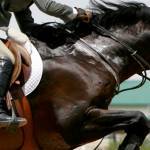Conditioning Horses for Performance: Slow But Not Always Steady

Most horse owners know that they can’t take an idle horse out of the field and have him ready to win a race, negotiate a course of show jumps, or complete an all-day trail ride without a period of conditioning. Those who try to short-cut the necessary buildup of fitness often end up with horses that are sour at best and lame at worst. To get the best results and avoid the possibility of serious injuries, horses should be trained in a program that asks for gradual improvement, guided by the specific fitness response of each horse.
Several basic principles guide most conditioning programs. First, the training must overload the current level of fitness. This means that the trainer must ask the horse to do somewhat more work than it is used to doing, in order to increase ability. This overload must be significant enough to produce an effect in which the body responds by building muscle strength, increasing cardiovascular fitness, and augmenting respiratory efficiency. The demand must not be extreme enough to cause injury, however, and trainers must realize that the increased work a horse can tolerate may be different for each equine.
Another principle of training is that the workload must continue to increase as fitness is built. As the horse reaches better condition so that a task doesn’t cause some level of stress, the exercise must be made more difficult or be carried out faster or for a longer period of time. This progression is not steady for most horses because each animal will respond in its own way. Horses with a lot of energy may be willing to do more than their bodies can easily tolerate, leading trainers to upgrade their demands too quickly. Likewise, horses with a calm or lazy temperament might seem tired and overstressed while performing at a much lower level of exercise.
A third guideline of conditioning is that training must be specific to the discipline toward which the horse is being pointed. While the earliest training steps might be the same for horses in all disciplines, eventually jumpers and endurance horses and barrel-racing mounts will be asked to perform different types of exercise in their training regimen. This specific conditioning will allow horses to gain strength and agility in ways that are most helpful for their particular performance demands.
Changes in fitness are obvious within the first month of training as the horse begins to look more muscular and recover more quickly after exercise. Changes in bones and connective tissue occur much more slowly, taking at least two to three months of moderate exercise to become stronger and more able to withstand loading. Gradual introduction of faster work can begin at this time to increase the horse’s speed and endurance. Rushing the training program during the early months often leads to injuries that set the schedule back significantly.
As training continues, the trainer needs to keep track of a number of things to assess how well the horse is progressing. Heart rate is a good indicator of how much a horse has been stressed by training. From a resting heart rate of around 40 beats per minute, the rate will rise with exercise but will also be influenced by weather, proximity to other horses, and the animal’s temperament. Trainers should find the resting heart rate for the horse they are working and can keep track of the rate during exercise by using a monitor. Out-of-condition horses will have higher heart rates during exercise and will take longer after a training period for the rate to return to normal. By recording the horse’s heart rate at five and ten minutes after exercise, the trainer can decide whether the horse needs to stay at the current training level, move to harder tasks, or possibly back off a bit and take more time to adapt to what is being introduced.
Trainers also need to be aware of behavior that can show stress in horses that are being trained. Horses that become extremely irritable or nervous, object to being handled or tacked up, or begin to pace or weave in their stalls may need to have their training slowed a bit. For stalled horses in training, a few hours of daily turnout may help to keep them fresh and willing to work.
Feed management is important for horses that have been idle and are now entering training. Diets should be based on high-quality forage, with grain added as needed to meet the energy demands of increased exercise. Each horse’s weight should be monitored as training progresses, and horses that lose weight should be provided with more forage as well as extra small grain meals spaced throughout the day. Feeds that provide part of the energy from fat sources are a good choice for horses in intense exercise. These feeds also promote calm behavior in some horses that become too energetic on traditional high-starch feeds.
Horses that back off their feed may be showing signs of gastric ulcers, a common problem in performance horses. RiteTrac and EquiShure, two digestive tract conditioners developed by Kentucky Equine Research, are helpful in supporting gut health and preventing the discomfort of hindgut acidosis.








